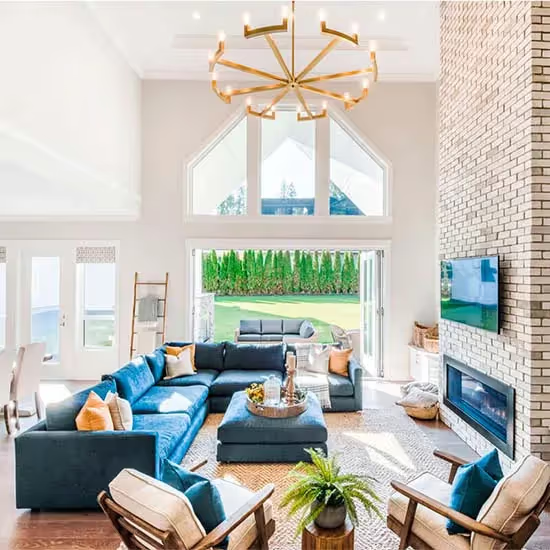What Is Coastal Interior Design?
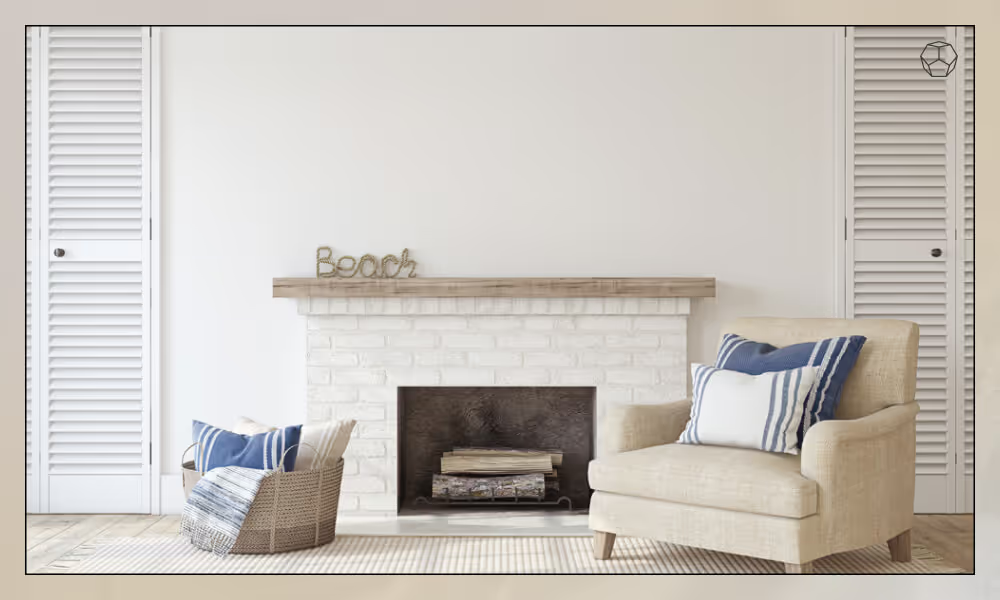
Coastal interior design is equal parts light, airy, and organic. It borrows hues, textures, and motifs from the seaside to create coastal spaces that make you feel like you’re relaxing in a luxe beach house. According to Franklin, “Coastal style is defined by seaside elements and colors. To achieve the look, add in textured elements like driftwood and rope while keeping the overall feel clean and simple.”
Speaking of clean and simple, coastal looks are all about neutral hues, punctuated by blues and greens to give spaces a peaceful feel. “Typically, a lot of blues and neutral colors will be used throughout, and it will often feel as if it is summer all year round in your home,” says Franklin.
Coastal looks are also more casual than many of their aesthetic counterparts, helping to create spaces that feel calming and inviting without sacrificing an elevated, intentional feel.
What Are the Benefits of Coastal Design?
The coastal design style offers benefits for anyone who wants to feel relaxed and at ease in their home. This breezy style incorporates textures and colors from nature to infuse spaces with a sense of peace and tranquility. “Coastal interior design is a very soothing and relaxing style,” attests Franklin. “This style allows you to bring the outdoors in, and reflect a relaxing beach day whether you are near the coast or not.”
“This style allows you to bring the outdoors in, and reflect a relaxing beach day whether you are near the coast or not.”
In addition to featuring relaxing textures and color schemes, coastal designs are often open, casual, and clutter-free, providing a soothing balm for chaotic days. “Coastal interior design promotes open space and discourages clutter,” said Moiseoff. “It generally evokes a very relaxed and laidback vibe which can be beneficial if you tend to be a more anxious person.”
What Are The Elements Of Coastal Design?
Organic Furniture

“A lot of coastal furniture is made of wicker or weathered woods and fabrics,” says Moiseoff. So when shopping for a coastal interior update, look for pieces that incorporate natural materials, like rattan, wicker, and bamboo frames.
Coastal designs also lean minimalist, casual, and comfortable, so pieces with simple silhouettes that emphasize comfort are great fits for this aesthetic. Think comfy bistro sets, rattan chairs, and plush white sofas.
Lots of Light
When we say coastal looks are light and airy, we mean that figuratively and literally. In fact, lots of light, particularly natural light, is a key tenet of coastal design. “Coastal interior design is meant to evoke the breezy vibe of the beach so you'll often see big windows and skylights,” says Moiseoff. “You basically want to bring in as much natural light as possible.”
If your space doesn’t have much in the way of natural light, you can make it look like it does by adding a variety of different light sources, such as overhead lighting and floor lamps. Consider adding daylight bulbs to these sources to mimic light from the sun.
White Paint with Neutral Accents
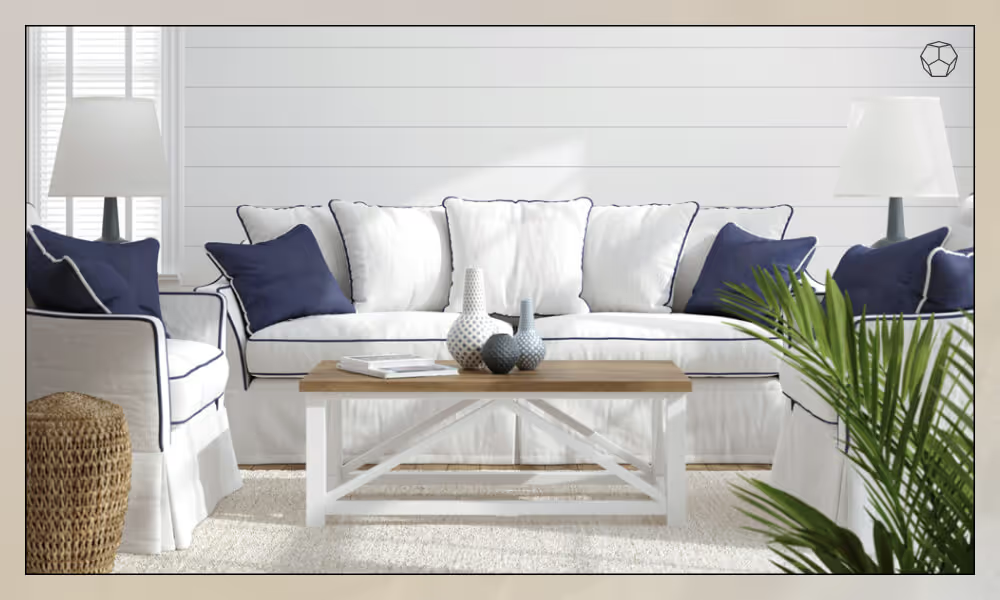
Speaking of white, the innately light and bright hue is a perfect match for coastal styles. “A crisp white is generally the main color of coastal interiors,” says Moiseoff. “It helps accentuate the natural light and give an airy vibe.”
White also helps bring out the other fundamental colors of coastal styles, allowing you to easily “accent with colors such as beige, light blues, greys, and greens. Even a darker navy blue can be a nice accent.”
Wood Flooring
Given what an important role organic elements have in coastal interior design, it’s no surprise that wood floors are a perfect match for this aesthetic. But not just any wood finish will give you a purely coastal look; wood floors with light finishes, as opposed to dark, are key to nailing this style.
That said, there are no hard and fast rules for interior design. So if you have beautiful dark wood floors, you can absolutely pair them with coastal elements to create a dynamic design with compelling contrast.
Natural Elements
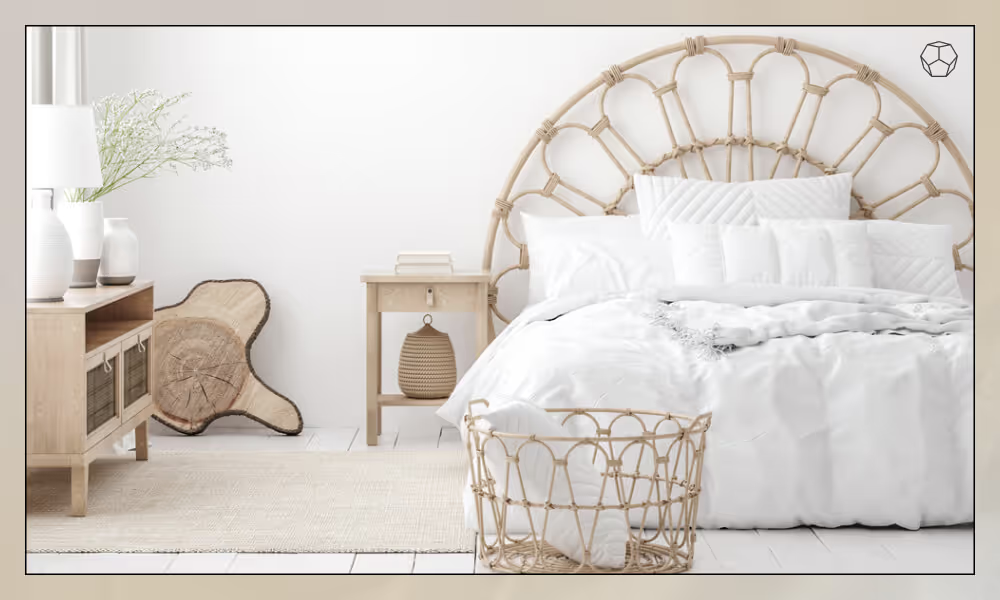
Natural elements in coastal designs can extend well beyond furniture. Popular coastal home decor pieces include textural rugs, seashells, and decorative driftwood. “To incorporate natural elements,” advises Franklin, “Use rugs made of jute, and select home decor that uses driftwood and light-toned woods.”
You can also incorporate light, organic fabrics, like billowy linen curtains and airy cotton throw blankets, to enhance your coastal look. Basically, if it comes from nature and rocks a light and breezy vibe, it’s probably a great fit for coastal interior design.
3 steps to Getting Started with Coastal Interior Design
1. Find Inspiration
The Internet offers a treasure trove of coastal design inspiration. According to Franklin, perusing inspiration-heavy platforms like Pinterest can, “help you figure out your color palette, as well as the main colors and textures you want to feature and highlight in your home.”
These platforms make it easy to save photos that catch your eye and put them all in one place. After you spend some time favoriting the photos you love most, you’ll likely start to see common colors, patterns, and designs that you can use to inform your own coastal style.
2. Decide on your Color Palette
Once you hone in on the colors you love most, you can put them together to create a cohesive color palette. Franklin recommends going with a “blue and white color story,” since these hues are inherent in coastal style.
But if you’re not keen on blue, you can also get a coastal look by choosing “white as the main focus and light natural colors as accents,” recommends Moiseoff. Shades of seafoam green can also help you create a coastal aesthetic if you’re looking for an accent color to use alongside whites and grays.
3. Look for Coastal Furniture and Decor
After deciding on a color palette, it’s time to hunt for furniture and home decor for your new look. “Look for furniture, rugs, and decor that reflect the natural textures you would see at the beach,” advises Franklin. A slipcovered sofa also works nicely in a coastal-style living room.
It’s also a great idea to incorporate furniture with organic accents, like wood and rattan. “Look for natural wood furniture and light fabrics and upholstery,” recommends Moiseoff. “Then do all you can to open up the space and let in as much natural light as possible.” Short on natural light? Consider incorporating more light sources to get the bright and airy feel inherent in coastal looks.
How to subtly add coastal elements to your home
One of the best aspects of coastal interior design is that you don’t need to go all-in on the look to reap its benefits. Adding just a few coastal design elements, like wood accents or woven or nautical decor, can uplift an aesthetic with an inviting, beachy vibe.
“If you don’t want to go for a full coastal design, try incorporating a few woven materials into your current décor,” recommends Franklin. “Woven elements connect the indoors with the outdoors while bringing a casual feel to the home. You can also add greenery reminiscent of being on the beach or in a tropical location.”
Coastal Room Design Ideas
Considering its various components, incorporating coastal design might feel overwhelming, but according to Franklin, it really comes down to just two key elements:
"The key elements to include in coastal rooms are shades of blue and natural textures you would find at the beach.” But don’t think you need one particular shade of blue to make it work; any shade reminiscent of the ocean, ranging from a light frothy blue to a rich deep-sea blue will work: “Whether you go dark or light with the blue,” says Franklin, “this color selection is key as it reflects the different tones of the ocean in the decor.”
In addition to shades of blue, organic materials help define a coastal look. Franklin recommends incorporating natural accents, like rattan, wood, and seagrass into “furniture or decorative elements, like placemats and coasters, to make the coastal design flow.”
Coastal Bedroom
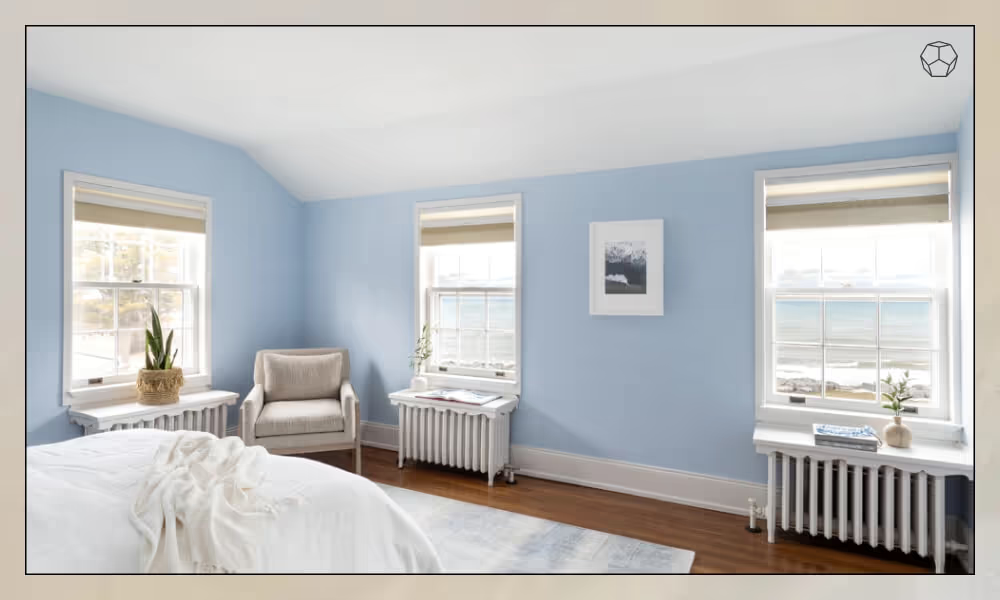
The bedroom is where we go to unwind and relax after long days, so it particularly lends itself to the soothing, tranquil feel of coastal interior design. This space, designed by Anna Franklin, combines pared-back furniture and decor with coastal elements, like blue walls and woven accents, to create a beachy feel that’s equally airy and calming.
Painting your bedroom walls light blue is a simple way to lay a coastal foundation. But you can also paint your bedroom walls white and add blue accents, like blue bedding or even fresh blue flowers. Then top it off with some organic elements, like woven baskets, decorative driftwood, and beige window treatments, to complete your look.
Coastal Dining Room
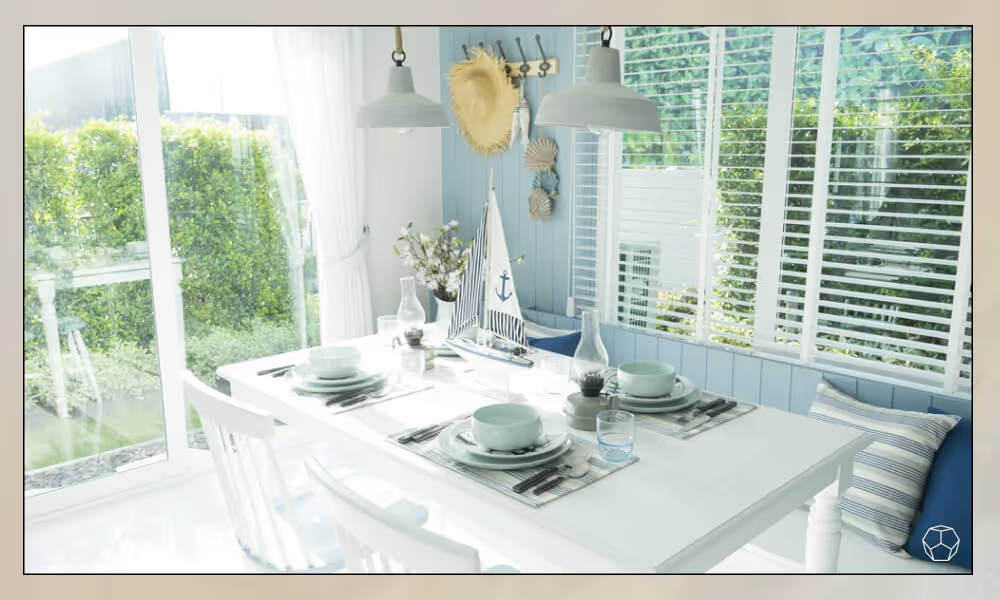
The innately casual feel of coastal style makes it a particularly great fit for casual dining spaces, such as breakfast nooks like this one. But you can infuse coastal vibes into a more formal dining area as well.
If you’re looking to create a casual coastal dining space, consider purchasing a set of bistro chairs with rattan frames and a blue-and-white motif. In more formal dining spaces, you can stick with whatever furniture feels right to you, then add coastal details through your table settings, like baby blue dishware and beige linen napkins.
Coastal Living Room
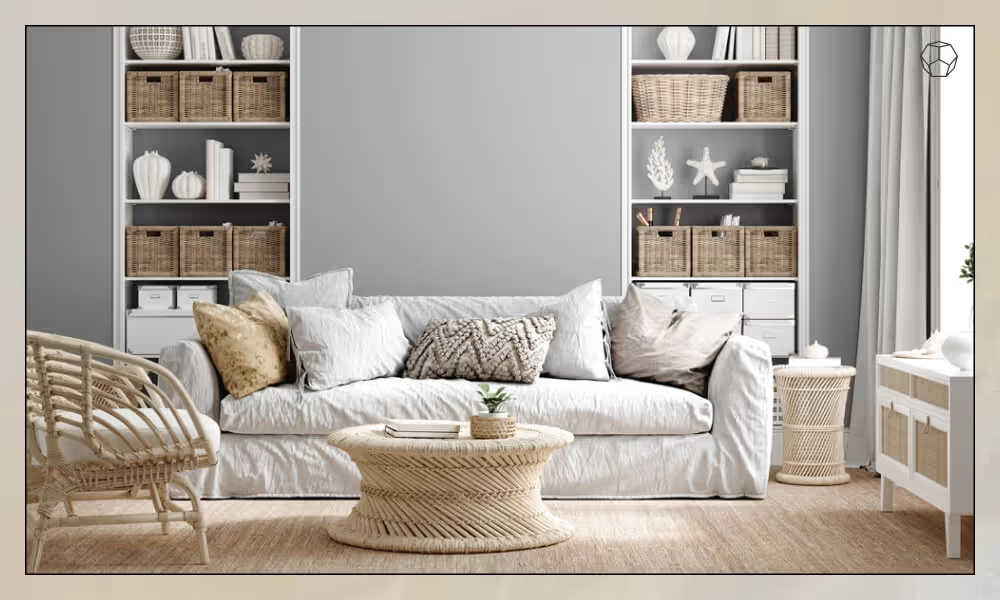
Coastal styles often have a transitional feel, combining traditional shapes and silhouettes with more contemporary hues and materials. This combination lends itself particularly well to layering, allowing you to add as many or as few coastal design elements as you see fit. So you can go full-on coastal to feel like you live in a beach house or simply add a few elements to offer a hint of coastal cool in your home design.
If you’re not sure where to start, consider incorporating a large area rug with natural fibers, like jute. This will help you set a coastal tone that you can layer on top of. Some good layering elements include textiles, like throw blankets and rugs, as well as smaller home decor pieces, such as seagrass baskets, ceramic vases, and decorative driftwood. To ensure these items have a coastal feel, look for pieces that incorporate a blue-and-white color scheme or natural fibers and materials.





